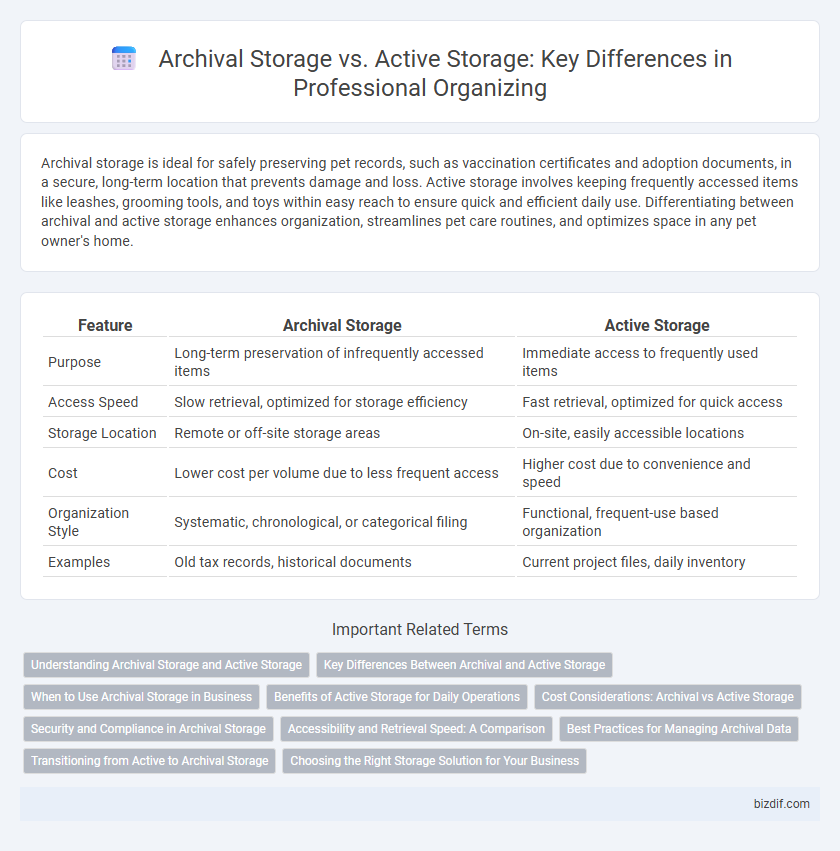Archival storage is ideal for safely preserving pet records, such as vaccination certificates and adoption documents, in a secure, long-term location that prevents damage and loss. Active storage involves keeping frequently accessed items like leashes, grooming tools, and toys within easy reach to ensure quick and efficient daily use. Differentiating between archival and active storage enhances organization, streamlines pet care routines, and optimizes space in any pet owner's home.
Table of Comparison
| Feature | Archival Storage | Active Storage |
|---|---|---|
| Purpose | Long-term preservation of infrequently accessed items | Immediate access to frequently used items |
| Access Speed | Slow retrieval, optimized for storage efficiency | Fast retrieval, optimized for quick access |
| Storage Location | Remote or off-site storage areas | On-site, easily accessible locations |
| Cost | Lower cost per volume due to less frequent access | Higher cost due to convenience and speed |
| Organization Style | Systematic, chronological, or categorical filing | Functional, frequent-use based organization |
| Examples | Old tax records, historical documents | Current project files, daily inventory |
Understanding Archival Storage and Active Storage
Archival storage refers to long-term data retention systems designed for infrequently accessed information, prioritizing durability and cost-effectiveness over speed. Active storage supports frequently accessed data, enabling quick retrieval and real-time editing for ongoing projects. Understanding the distinction helps professionals optimize organization strategies by aligning storage solutions with data usage patterns and business needs.
Key Differences Between Archival and Active Storage
Archival storage is designed for long-term preservation of infrequently accessed data, prioritizing durability and cost-effectiveness, whereas active storage supports frequent, real-time data retrieval with faster access speeds. Key differences include latency, with archival storage exhibiting higher latency due to slower access times, and cost structure, as archival solutions are typically more affordable per gigabyte but less optimized for quick data recovery. Data management strategies must consider these distinctions to balance storage efficiency, access requirements, and budget constraints.
When to Use Archival Storage in Business
Archival storage is ideal for businesses needing long-term retention of infrequently accessed documents such as tax records, legal files, and compliance materials. This storage method offers cost-effective solutions for preserving data integrity over time while reducing clutter in active workspaces. Choosing archival storage supports regulatory adherence and ensures critical information remains secure and retrievable without occupying valuable active storage resources.
Benefits of Active Storage for Daily Operations
Active storage enhances daily operations by providing immediate access to frequently used documents and materials, streamlining workflow efficiency. Its design supports rapid retrieval and real-time updates, reducing downtime and minimizing errors during task execution. By prioritizing accessibility over preservation, active storage optimizes organization systems for dynamic and fast-paced work environments.
Cost Considerations: Archival vs Active Storage
Archival storage offers a cost-effective solution for long-term data retention, typically featuring lower storage costs but higher access fees compared to active storage. Active storage ensures rapid data retrieval with higher ongoing expenses, suitable for frequently accessed information in professional organizing systems. Balancing these cost considerations helps organizations optimize budgets by aligning storage choices with data usage patterns and accessibility requirements.
Security and Compliance in Archival Storage
Archival storage provides enhanced security features such as encryption, access controls, and tamper-evident technologies to ensure long-term data integrity and confidentiality. It complies with regulatory requirements like GDPR, HIPAA, and SOX by preserving records in immutable formats and maintaining detailed audit trails. Active storage, by contrast, prioritizes quick access over compliance, making archival storage essential for organizations with strict data retention policies and security mandates.
Accessibility and Retrieval Speed: A Comparison
Archival storage is designed for long-term preservation of documents with slower retrieval speeds, suitable for infrequently accessed files, while active storage prioritizes rapid accessibility and quick retrieval for frequently used materials. Professional organizers must assess the balance between ease of access and storage longevity to optimize workspace efficiency. Implementing a hybrid system combining archival and active storage enhances productivity by ensuring critical documents remain readily retrievable.
Best Practices for Managing Archival Data
Implementing best practices for managing archival data requires distinguishing between archival storage and active storage based on usage frequency and data criticality. Archival storage prioritizes long-term preservation, employing durable media, consistent data verification, and metadata management to ensure integrity and retrievability over time. Active storage focuses on rapid access and regular updates, necessitating optimized indexing and performance monitoring to support ongoing professional organizing workflows.
Transitioning from Active to Archival Storage
Transitioning from active to archival storage involves moving infrequently accessed documents and digital files to a more cost-effective, long-term storage solution designed to preserve data integrity over time. Professional organizers assess usage patterns and retention requirements to determine when items should shift from active use in daily workflows to archival storage, ensuring easy retrieval without cluttering primary workspaces. Implementing a clear indexing system and secure archiving methods facilitates efficient management and compliance with regulatory standards during this transition.
Choosing the Right Storage Solution for Your Business
Choosing the right storage solution for your business depends on whether documents require regular access or long-term preservation. Archival storage is ideal for files that need to be securely stored but rarely accessed, offering organized, space-efficient, and compliant retention. Active storage supports frequent retrieval and updates, enhancing workflow efficiency and collaboration for day-to-day operational documents.
Archival storage vs Active storage Infographic

 bizdif.com
bizdif.com